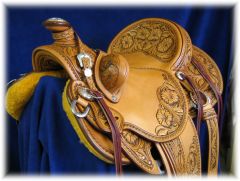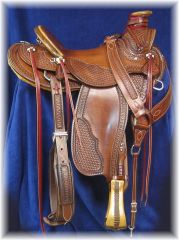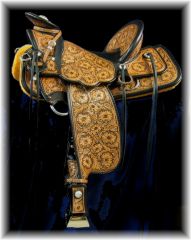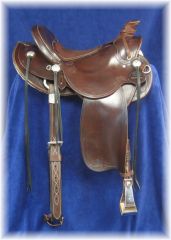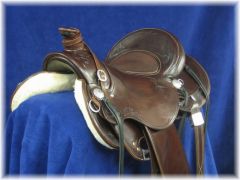-
Posts
726 -
Joined
-
Last visited
Content Type
Profiles
Forums
Events
Blogs
Gallery
Everything posted by Go2Tex
-
Rubber cement usually just rubs off anyway. It doesn't seem to penetrate. Try it on regular contact cement. About the best thing I've found for that is the stuff they sell at autoparts stores for removing road tar. Then lots and lots of deglazer will maybe allow the dye to penetrate the leather where the glue was, but don't count on it.
-
Well ok, here comes the critique on the leather I got from Thoroughbred. I ended up ordering the dark brown skirting which they call DOA. No, not dead on arrival. At least, not yet. It is a very dark brown, which is exactly what I wanted. My initial impression was positive. The sides were large, firm, heavy, and not much run-off. The flesh side was nice also and would have worked well for a roughout. I only had a couple of cuts to work around but no problem getting a good seat and fenders. The color, however looked uneven until oiled and then seem to even out and was quite dark. So far so good. It did not soak up water very well so it was difficult to work with. The seat was a b**ch. Carving was not a big problem as I am used to a bit of drag on drum dyed leather. Plus, I was only doing a little finger carving details. And here is the result: I really like the color. It works very well with dark havana english bridle or harness tack. The jury is still out on how durable it is in the long term and how well the color holds up. Has anyone had any problems with the color fading?
-
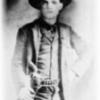
Head To Head Or Head To Tail On Sheepskin?
Go2Tex replied to GrampaJoel's topic in Saddle Construction
I'm afraid to admit that my scrap wool is slowly but surely inundating my shop. I try to use it up as much as possible in the usual ways, like spreading dye and glue, and antique etc. I even started using it to pad the saddles I ship. I figure, what the heck, they paid for it. And, maybe they can find a good use for it. I made myself some comfy house shoes out of it. I look like Nanook of the North with a Barney Rubble flair. So no, I haven't a clue what to do with it. I'm considering making a giant throw rug out of it. -

Head To Head Or Head To Tail On Sheepskin?
Go2Tex replied to GrampaJoel's topic in Saddle Construction
Yeah, the Stohlman explanation makes a lot of sense but I'm not convinced that it makes much difference in keeping the blanket from slipping back. Frankly, when I look at a $60 shearling and see all that waste from arranging the skirts butt to head, I find myself very very tempted more and more to test the theory. -
Getting those jocks to pull down tight is demonstrated in the Stohlman encyclopedia of saddlemaking no. 2.
-

Slaughter Free Leather Not Selling As Expected
Go2Tex replied to Johanna's topic in Leatherwork Conversation
The issue here is one of semantics stemming from the demonization of the entire meat industry and anything to do with humans generally by people who have been brainwashed by the self loathing, anti-human liberal media. The idea that death by any means other than dying in one's sleep, doctor assisted suicide or a drug overdose can be anything other than entirely unpleasant, is as laughable and deserving of complete ridicule as Algore's man caused global warming. Anyone who would pay 10x more for something because it was killed by "mother nature" rather than a captive bolt slamming against its skull, or a lead slug from a politically incorrect "assault rifle", deserves to be taken to the cleaners by every snake oil salesman who comes along...... and I mean that in the good way, Steve. If you can sell grain damaged leather for 10x what it would otherwise sell for, I say more power to ya but I'm still trying to figure out how to sell the undamaged, horrifically slaughtered stuff I have on hand due to the bottom falling out of the "normal" market because some smarmy liberal politicians decided to force banks to give home mortgages to people who couldn't afford to over-eat at McDonalds 7 days a week. But, if some sandal wearing, tree hugging, whale saving, earth worshipping man hater comes along and is looking for some humanely euthanized cow hide leather chaps to wear to an Obama rally, I'll just tell her that all my leather comes from happy cows raised in my back yard....or, maybe down the road a piece.... but, hey, they died,... eh, passed away, with smiles on their faces and a full belly of natural, organically grown, Coastal/Bermuda wild grass hay. And if she believes that, maybe I can sell her a nice, earth friendly, cat-o-nine-tails whip to complete her ensamble. -
I also use the 1/2" thick poly cutting board and it works well for cutting, but I like the black rubber poundo stuff for punches and awls. The only problem with the poly cutting board is that it eventually gets a lot of cut marks that can mark up your wet or cased leather. I tried sanding, but it was a lot of time and work and didn't really remove them completely. So, like any work surface, it has it's drawbacks and I've just learned to protect the leather when working in that area. Eventually, I replace that section of board.
-

Tooling Prior To Wet Forming..?
Go2Tex replied to iamasmith's topic in Gun Holsters, Rifle Slings and Knife Sheathes
The "black marks", or stains from the tacks is caused from a reaction of the wet leather to iron. You can remove those stains with oxalic acid, commonly sold as wood bleach. A spoonful of oxalic acid in pint or so of warm water will do the trick. It works best on wet leather, before it has been finished. Caution! Do NOT get the stuff on your skin. Use rubber gloves. -

C.s. Osborn Bag Punch
Go2Tex replied to Sixer's topic in Gun Holsters, Rifle Slings and Knife Sheathes
Yeah, I have the same problems with some punches. It might be the hammer and/or the surface. Try a bench anvil with leather scrap to protect the punch. You need a really firm surface to get some larger punches through leather. Also, it could use some sharpening too. Try stropping it a bit. If you have a buffing wheel it might help. -

Tooling Prior To Wet Forming..?
Go2Tex replied to iamasmith's topic in Gun Holsters, Rifle Slings and Knife Sheathes
I agree with JR. I always wet fit the leather, let it dry completely to set the shape, then rewet, flatten it out as needed for carving or stamping, then rewet shape as gently as possible. It works for saddle cantel bindings, so it will work for anything. -

New Day Timer
Go2Tex replied to Double U Leather's topic in Purses, Wallets, Belts and Miscellaneous Pocket Items
Let it roll, eh? heh heh...good one. Let me know if you master the ability to erase a knife cut. -
Now that is a nice little twist on it. Having those fittings manufactured for you must really cost a lot per collar, though.... Innovation is so often squashed by the accountants. I'm wondering how you reinforced the collar to keep the fitting from pulling through and how is the bolt then installed? Is there a nut threaded onto it or is the ball and ring threaded onto the bolt? If so, do you then just use thread lock to keep it from unscrewing? Just curious about the construction. Beautiful collar, though.
-
Weaver Leather carries a large selection of case making fittings, hardware, fasteners and hardware. You do need to have a tax number, though, as they are wholesale only. http://www.weaverleather.com/
-
Yeah, this is one area that I usually have to be very careful about too. The wetter the leather when you carve and stamp, particularly a geometric/basket stamp, the more distortion you'll get. It means you must really make sure when you do your fitting up that you spike it down good under or at the swells and tack the front jockey and ears. That way, once it is carved/stamped you have plenty of reference points to realign it with. There are always a few surprises up front and I just have to wrestle it back into shape. It is also the reason I make sure to not put marks or tacks on the fork cover anywhere close to the edge of the seat. An ounce of prevention is worth a pound of cure.
-
From the album: Brent's Saddles
© © leatherworker.net
-
-
From the album: Brent's Saddles
© © leatherworker.net
-
From the album: Brent's Saddles
© © leatherworker.net
-
From the album: Brent's Saddles
Taylor Tree, dark brown leather, western dressage© © leatherworker.net
-
From the album: Brent's Saddles
© © leatherworker.net
-
Yeah, me too. I take it, this is a tool you would use to skive the edges of a strap?
-
I ran across this thread doing a search for sword scabbards, as I recently had a project myself to replace the leather scabbard for a Civil War era sword. I ran into the same issue with the scabbard being too floppy and I too returned the finished job to the customer without taking photos. But I did manage to get some pics of the original scabbard, in pieces, with the brass fittings and the sword. I found that the scabbard was not stitched, but simply lap skived and most likely glued and held in place by the fittings which had set screws, indicating that they were slid onto the leather, and not formed around it. The fittings were very smooth on the inside and made no marks on the leather, even after being finished. The original leather was very hard and brittle, which of course was the reason for the replacement as old leather does get hard and brittle with age. It also cracks and falls apart, as this one did when trying to remove the fittings. So, it is hard to tell just how firm the original scabbard was when new but obviously it would need to hold it's shape upon withdrawing the sword, which presents the problem at hand; ....How to make it stiff enough without being too thick or brittle. The brass fitting at the tip of the sword was heavy and tended to cause the scabbard to droop quite noticeably with the sword removed. My particular customer was not too concerned about the floppness as it was merely for display and a dowel placed inside would do the trick for her, as the sword would be displayed removed from the scabbard. However, I was and still am concerned, as it just wasn't quite right. In reading this entire thread, I noticed a comment regarding the half tanned leather. As it just so happens, I just ran across a source of this very type of leather. The Clayton Leather Co, through their USA affiliate, Booth and Company Leather Traders USA lists a half tanned, rawhide center product. "Rawhide, a partly tanned leather with a raw streak in the centre for added strength, used for saddlery strap leathers." http://www.claytonleather.com/saddlery.htm So, whether or not this leather would be suitable for a leather scabbard is hard to say, but I suspect this would be worth checking out. The procedure of pouring very hot water, perhaps a mixture containing wax into the formed leather tube, or soaking it, and then drying under heat has even more appeal. Another way of producing a rather rigid leather, though also quite brittle, as I found out when trying to bend it, was achieved by emersing the leather in baking soda and drying in the hot summer sun. It was quite dark as well and appeared burned, which I suspect it was.(it gets damn hot down here in south Texas). So, perhaps some trial and error could produce the amount of rigidity desired without being too brittle.
-
Hey, Thanks Kevin! That's great info. Please let me know how you like the leather from Booth. PM me if you'd like. I very much appreciate it. Chasing down a good source of leather is the hardest part of this business. I checked out their website, ( http://www.boothandco.com/products.htm ), and the link to Clayton Street Tannery, Chesterfield, Derbyshire, ( http://www.claytonleather.com/saddlery.htm ). Looks promising. Mucho gracias.
-
A month to get a reply? So, how long did it take to get the leather??? I've never heard of Booth. How do their prices for their English leather compare with Siegel?
-
The tannage is the same. OK. That's what I was asking. Good thing we don't speak different languages because we'd be here all day on this one.



